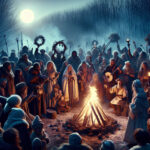The Pagan Bible is a collection of texts and beliefs from the pre-Christian religions of Europe, the Middle East, and North Africa. It contains a wealth of information about the spiritual beliefs and practices of ancient cultures and serves as an invaluable resource for anyone interested in exploring the spiritual roots of many of the world’s modern religions. In this article, we will explore the history of the Pagan Bible, its contents and how it has influenced modern religion. We will also look at how Paganism has been passed down through the centuries, and how it continues to be practiced today.
The Pagan Bible
The Pagan Bible is a collection of sacred texts, writings, and practices that form the basis for contemporary Paganism. It is an important source of information for those who are interested in learning more about Paganism and engaging in the practice. This article will provide an overview of the Pagan Bible, including its origins, contents, and how it is used in modern Paganism.
History of the Pagan Bible
The Pagan Bible is a collection of ancient texts and teachings that have been gathered together over the centuries. Many of these texts are centuries old, and some are even millennia old. While some of the texts may have been written by Pagan authors, many of them are also sourced from other religious traditions.
The earliest known Pagan texts were written in the Middle East, around 4,000 years ago. These texts were written in the Sumerian language, and the most well-known are the Gilgamesh Epic, the Sumerian Epics, and the Hymns of Inanna. These texts were used by the Mesopotamian cultures to understand the gods, the afterlife, and the natural order of the world.
In the ancient Greek world, the most well-known Pagan texts were written by Homer and Hesiod. These texts were used to understand the gods and the divine order of the world. They also told stories of the gods and their interactions with mortals.
In the ancient Roman world, the most prominent Pagan texts were written by Virgil and Ovid. These texts were used to understand the gods, the afterlife, and the natural order of the world. They also told stories of the gods and their interactions with mortals.
In the Middle Ages, the most well-known Pagan texts were written by the poets of the time. These texts were used to understand the gods, the afterlife, and the natural order of the world. They also told stories of the gods and their interactions with mortals.
Contents of the Pagan Bible
The Pagan Bible is a collection of sacred texts, teachings, and practices that form the basis for contemporary Paganism. These texts and teachings come from a variety of sources, including ancient texts, contemporary authors, and Pagan traditions.
The most well-known texts of the Pagan Bible are the ancient texts written by Homer, Hesiod, Virgil, and Ovid. These texts provide information about the gods, the afterlife, and the natural order of the world. They also tell stories of the gods and their interactions with mortals.
In addition to these ancient texts, the Pagan Bible includes teachings from contemporary authors. These authors provide an insight into modern Paganism, including its practices and beliefs. Some of the more prominent authors include Starhawk, Margot Adler, and Scott Cunningham.
The Pagan Bible also includes teachings from Pagan traditions. These teachings provide an insight into the beliefs and practices of specific Pagan traditions, such as Wicca, Druidry, and Heathenry.
How the Pagan Bible is Used
The Pagan Bible is used as a source of information for those who are interested in learning more about Paganism and engaging in the practice. It is used as a reference for practitioners, to understand the gods, the afterlife, and the natural order of the world. It is also used to gain insight into Pagan beliefs and practices, as well as to develop one’s own spiritual practice.
The Pagan Bible is also used as a source of inspiration and guidance for those who are interested in creating their own rituals and practices. It can be used to connect with the gods, to understand the divine order of the world, and to create meaningful rituals that reflect one’s own spiritual path.
Conclusion
The Pagan Bible is a collection of sacred texts, teachings, and practices that form the basis for contemporary Paganism. It contains ancient texts, contemporary authors, and Pagan traditions. It is used as a source of information, inspiration, and guidance for those who are interested in learning more about Paganism and engaging in the practice.
The Pagan Bible is an important source of information for anyone interested in learning more about the ancient pagan religions. It provides a comprehensive overview of the beliefs, rituals, and practices of these religions and serves as an invaluable resource for anyone seeking to gain a deeper understanding of paganism. It is a must-have for anyone looking to explore the fascinating world of paganism. The Pagan Bible is an invaluable source of knowledge for anyone looking to explore and understand the ancient pagan religions.





